Vincent van Gogh – The Art and Life of Painter Vincent Willem van Gogh
Vincent Willem van Gogh, the quintessential anguished artist, endeavored to express his psychological and metaphysical condition in every one of his masterpieces, such as The Starry Night and Van Gogh’s flower paintings. Vincent van Gogh’s paintings, with heavily layered, palpable brushwork produced in a vibrant, luxurious palette, reflect the creator’s distinguishable character immortalized on canvas. Every Vincent van Gogh artwork reveals a distinct impression of how the master interpreted every scenario, as experienced through his senses, thoughts, and emotions. Van Gogh’s painting style was radically unique and emotionally compelling, and it has profoundly influenced painters and trends all through the 20th century and continued to the modern-day, ensuring his relevance for the conceivable future.
Table of Contents
The Life of Vincent Willem van Gogh
| Nationality | Dutch |
| Date of Birth | 30 March 1853 |
| Date of Death | 29 July 1890 |
| Place of Birth | Groot-Zundert, The Netherlands |
Vincent van Gogh’s artworks sought to express humanity’s inherent spirituality which culminated in a synthesis of approach and substance that led to dynamic, expressive, and emotive compositions that express much more than the subject’s apparent appearances.
In this section, we will be looking at the life of Vincent Willem van Gogh and answering questions such as “When was Vincent van Gogh born?” and “When was Vincent van Gogh alive?” We will also be exploring his early formative years, as well as his mature period. This will give us some insight into the experiences that influenced Vincent van Gogh’s paintings.
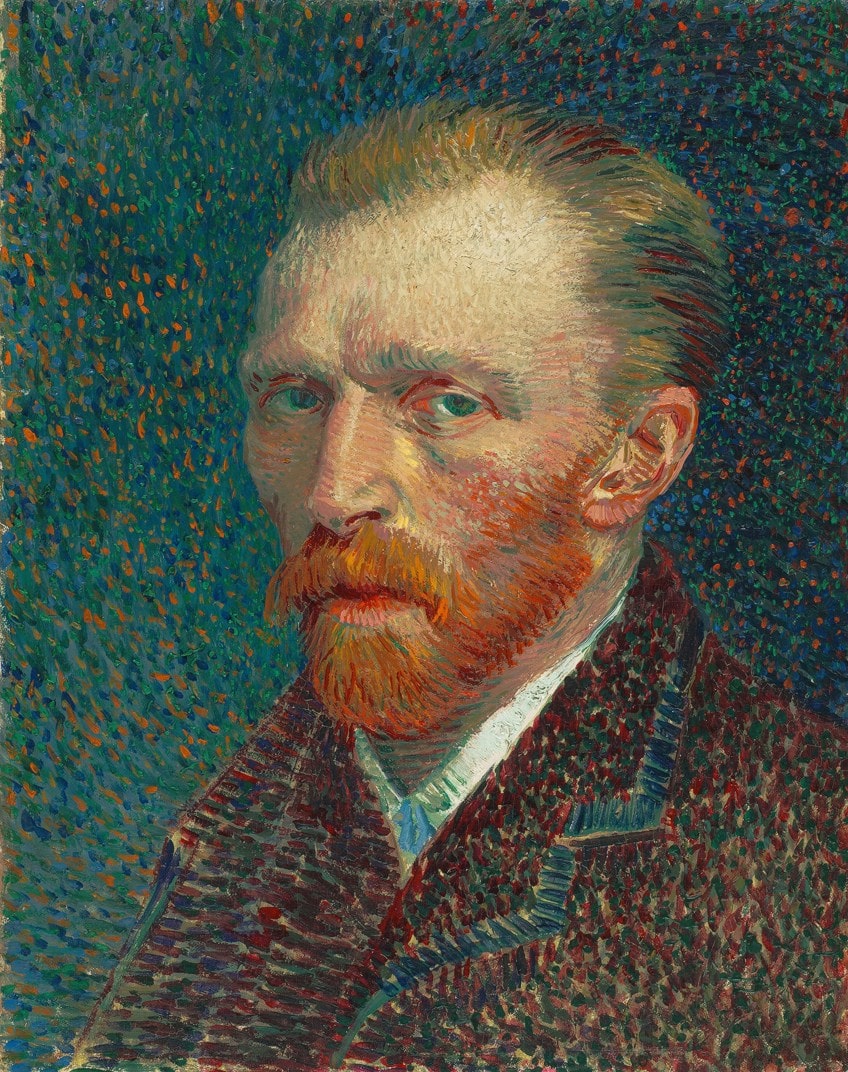
Childhood and Early Training
Vincent Willem Van Gogh was born in the south of the Netherlands as the second of six siblings into a pious household. Theodorus Van Gogh, his father, was a preacher, and Anna Cornelia Carbentus, his mother, was a bookseller’s child. Van Gogh had unpredictable emotions as a youth and had little early enthusiasm for artwork, although excelling at language while studying at several boarding schools. He discontinued his education in 1868 and never resumed formal study.
In 1869, Vincent Van Gogh began his job as an intern in the Paris offices of worldwide artwork dealers Goupil & Cie, eventually operating in the Hague branch of the firm.
He was a rather competent art dealer who lasted with the business for over a decade. In 1872 he began penning letters to Theo, his brother. This contact lasted till the end of Vincent van Gogh’s lifetime. Theo would go on to become an art trader the following year, while Vincent was transferred to Goupil & Cie’s offices, which were based in London. Van Gogh felt despondent about this period and surrendered to God. After repeated movements between Paris and London, Van Gogh was fired from Goupil’s and chose to enter the priesthood.

He gave all his assets to local coal workers while residing in southern Belgium as a penniless missionary until the church fired him due to his excessively zealous adherence to his belief. Van Gogh resolved in 1880 that he could be an artist while still serving God, stating:
“To attempt to comprehend the actual importance of what the great painters, the serious masters, teach us in their creations, that connects to God; one person penned or conveyed it in a book; someone else, in a painting.”
Van Gogh was still a peasant, but Theo gave him some funds to help him get by. Vincent van Gogh produced almost no income from his paintings, thus Theo financially backed his elder brother throughout his lifetime. Van Gogh was obliged to return home with his family a year later, in 1881, when he taught himself the art of painting. With his brother’s support, Van Gogh traveled to the Hague, leased a workspace, and studied under Anton Mauve, a prominent member of the Hague Group. Mauve exposed Van Gogh to the works of Jean-François Millet, a French artist known for representing ordinary workers and farmers.

Mature Period
Van Gogh began painting the worn palms, faces, and other physical traits of laborers and the impoverished in 1884, after relocating to Nuenen, Netherlands, with the intention of becoming an artist of rural life similar to Millet. His private life was in chaos, despite the fact that he had discovered a professional vocation.
Van Gogh criticized Theo for not working sufficiently hard enough to promote his artworks, to which Theo responded that Vincent’s gloomy palette was out of fashion in comparison to the bright and colorful manner of the Impressionist painters who were prominent at the time.
Their father passed away suddenly of a stroke on the 26th of March, 1885, placing expectations on Van Gogh to attain a successful career. Following this period, he finished The Potato Eaters (1885), the very first of van Gogh’s large-scale creations and masterpieces. In 1885 the young artist left the Netherlands, enrolling at the Antwerp’s Academy of Fine Arts.

There, he found the works of Baroque artist Peter Paul Rubens, whose whirling shapes and free brushstrokes had a significant influence on the young creator’s approach. The severity of the school’s academic standards, on the other hand, was not at all appealing to the artist, and he left for Paris the year after.
He relocated to Montmartre with Theo, Paris’s artistic district, and studied with painter Fernand Cormon, who introduced him to the Impressionists.
Van Gogh was inspired to use a brighter palette by the example of painters such as Camille Pissarro, Claude Monet, and Georges Seurat, as well as pressures from Theo to produce canvases. Van Gogh had a significant obsession with Japanese prints for a period that lasted from 1886 until around 1888 and began researching and collecting them with passion, even organizing an exhibition of them in a Parisian diner. In late 1887, Van Gogh organized an exhibit with his peers Henri de Toulouse-Lautrec and Emile Bernard, and in early 1888, he exhibited at the Theatre Libre d’Antoine with the Neo-impressionists Paul Signac and Georges Seurat.
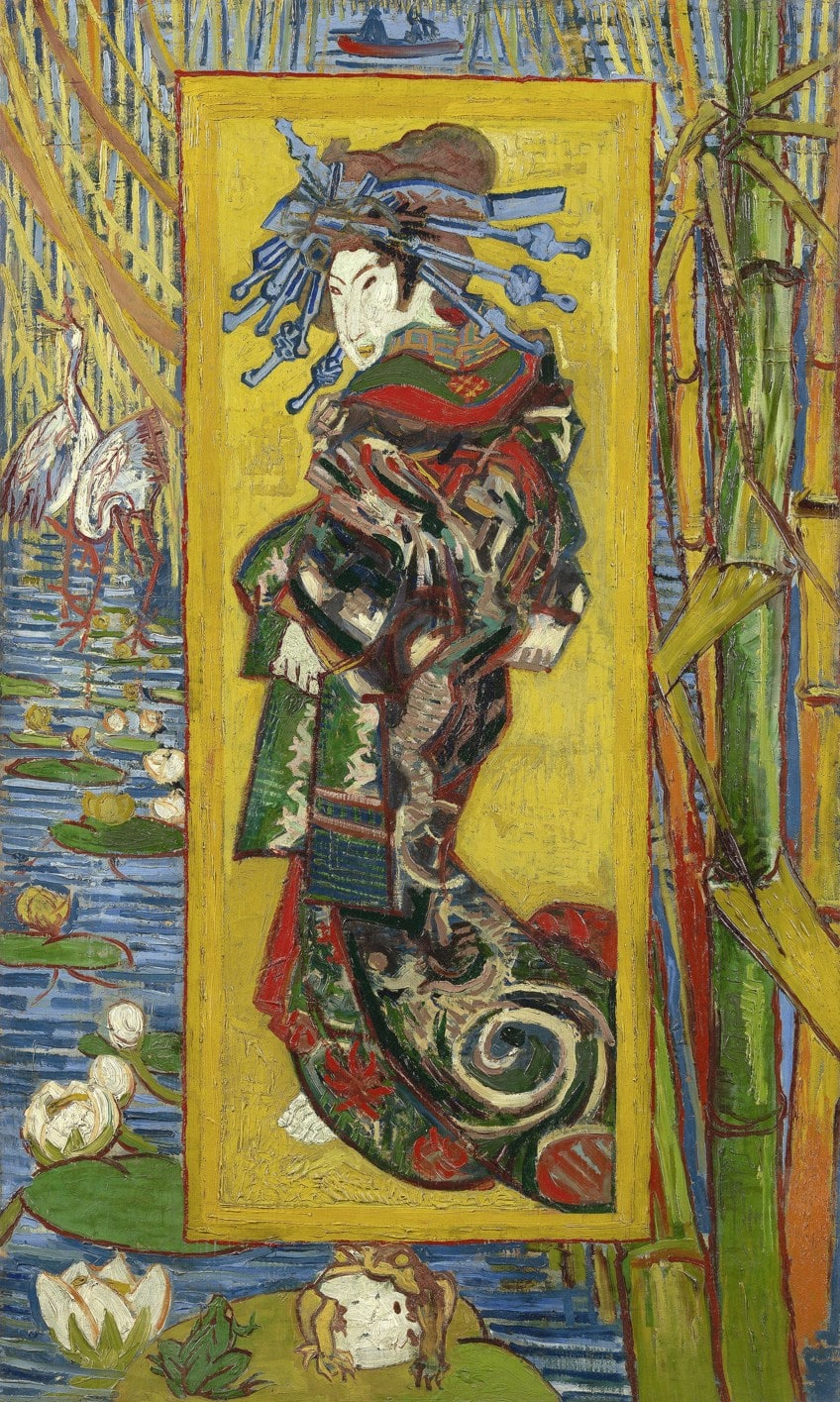
Later Years and Death
The bulk of Van Gogh’s most famous paintings were created during his last couple of years of life. Throughout the autumn and winter of 1888, Paul Gauguin and Vincent van Gogh lived and produced in Arles, where Van Gogh eventually rented the “Yellow House” because of its grapefruit color. The move to Provence began as an idea for a new creator’s community in Arles as an alternative to Paris, and it came at a critical point in each of the artists’ professions.
Van Gogh and Gauguin collaborated closely in the “Yellow House” and established a notion of color that was emblematic of inner emotion and not based on nature.

Despite his immense output, Van Gogh suffered from mental illness, which most likely included seizures, psychotic symptoms, hallucinations, and bipolar illness. Gauguin moved for Tahiti, partly to get away from Van Gogh’s increasingly unstable conduct. After a particularly violent confrontation in which Van Gogh assaulted Gauguin with a knife and eventually hacked off part of his ear, the artist sneaked away. Van Gogh deliberately took himself to a psychiatric facility in Saint-Remy, on the 8th of May, 1889, suffering from his declining mental state. His psychological state remained stable all throughout the following weeks, and he was allowed to commence creating.
This was amongst his busiest periods.
Van Gogh finished nearly 100 canvases throughout his time in Saint-Remy, notably The Starry Night (1889). The facility and its gardens were his major topics, which he depicted with the powerful brushstrokes and luscious colors that characterized his mature phase. Van Gogh immersed himself in the natural environs during supervised excursions, eventually reproducing from recollection the olives and cypress bushes, irises, and other flora that dotted the clinic’s grounds.
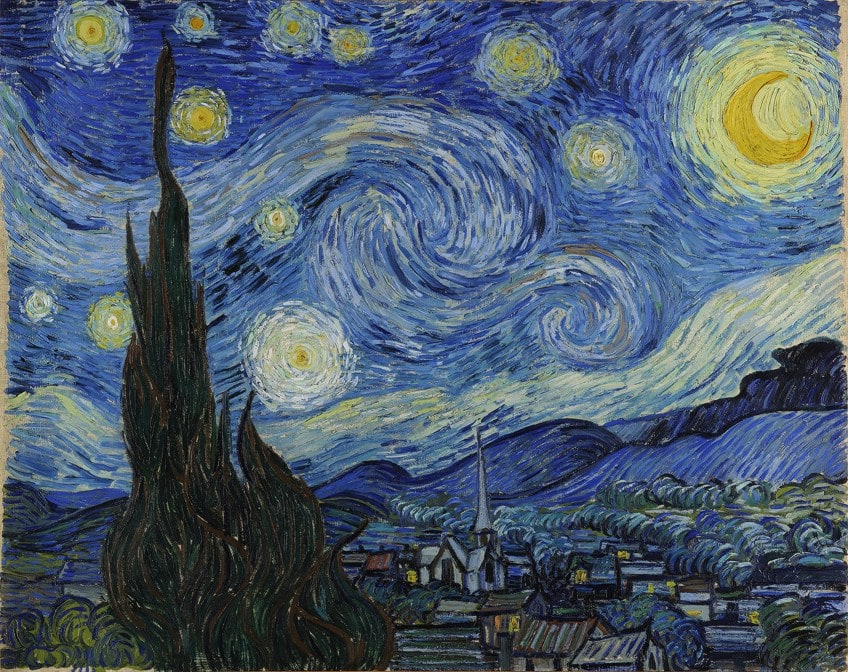
Van Gogh traveled to Auvers-Sur-Oise shortly after leaving the institution, to the care of Dr. Gachet, a homeopathy practitioner and amateur painter. The practitioner encouraged Van Gogh to produce as part of his recovery, which he eagerly consented to.
He meticulously chronicled his surroundings in Auvers, producing around one painting every day in the final months of his life.
However, once Theo revealed his intention to start his own firm and indicated that cash would be scarce for a while, Van Gogh’s sadness worsened dramatically. He walked into a neighboring wheat field on the 27th of July, 1890, and wounded himself in the torso with a handgun.
Legacy
Throughout art history, there are clear traces of Van Gogh’s enormous influence. The Fauves and German Expressionists followed Van Gogh’s lead and embraced his personal and spiritually motivated use of color. The Abstract Expressionists of the mid-20th century employed Van Gogh’s technique of large, emotive brushwork to reflect the creator’s mental and physical state.
Neo-Expressionists like Eric Fischl and Julian Schnabel were inspired by His expressive palette and brushstrokes in the 1980s. His life has influenced music and several films in mainstream culture. Van Gogh’s fame developed rapidly among painters, critics, traders, and collectors following his initial exhibits in the late 1880s. In 1887, André Antoine exhibited Vincent Van Gogh’s artworks alongside those of Paul Signac at the Théâtre Libre in Paris, and Julien Tanguy acquired six of them.
Albert Aurier defined Vincent van Gogh’s painting style in Le Moderniste Illustré in 1889 as “flame, passion, sunlight.”
Vincent Van Gogh’s art was reported to have captivated French President Marie François Sadi Carnot. Memorial shows were staged in The Hague, Brussels, Paris, and Antwerp following Van Gogh’s death. His art was featured in various high-profile exhibits, including six works at Les XX, and a retrospective display in Brussels in 1891.
Octave Mirbeau stated in 1892 that Van Gogh’s death was a “vastly grimmer loss for art” because “the masses have not congested to a splendid memorial service, and impoverished Vincent van Gogh, whose downfall implies the demise of a gorgeous torch of brilliance, has disappeared to his death as unknown and ignored as he lived.”
Van Gogh’s renown peaked in Germany and Austria prior to World War I, aided by the publishing of his letters in 1914. His letters are passionate and intelligent and have been hailed as among the best of their sort from the 19th century. These started a powerful mythos of Van Gogh as a passionate and committed artist who struggled and died for his craft.
Inspired by Van Gogh’s letters to Theo, author Irving Stone created Lust for Life, a historical book about Van Gogh’s life, in 1934. This work and the 1956 picture increased his renown, particularly in the United States, where Stone estimated that just a few hundred individuals had been aware of Vincent van Gogh’s paintings previous to his unexpected best-selling book.

Vincent van Gogh’s Art Style and Works
While in school, Van Gogh sketched and colored with watercolors, but just a few examples exist, and the authorship of several has been disputed. When he began studying painting as an adult, he began at the simplest level. In 1882, Cornelis Marinus, the proprietor of a well-known modern art gallery in Amsterdam, requested sketches of The Hague.
Van Gogh’s work fell short of expectations.
Marinus proposed a second contract, this time describing the subject matter in great detail, but was dissatisfied once more. Van Gogh persisted; at his studio, he played with lighting by utilizing varied shutters and various sketching mediums. For well over a year, he focused on single figures — incredibly complex white and black studies that drew only ridicule at the time.
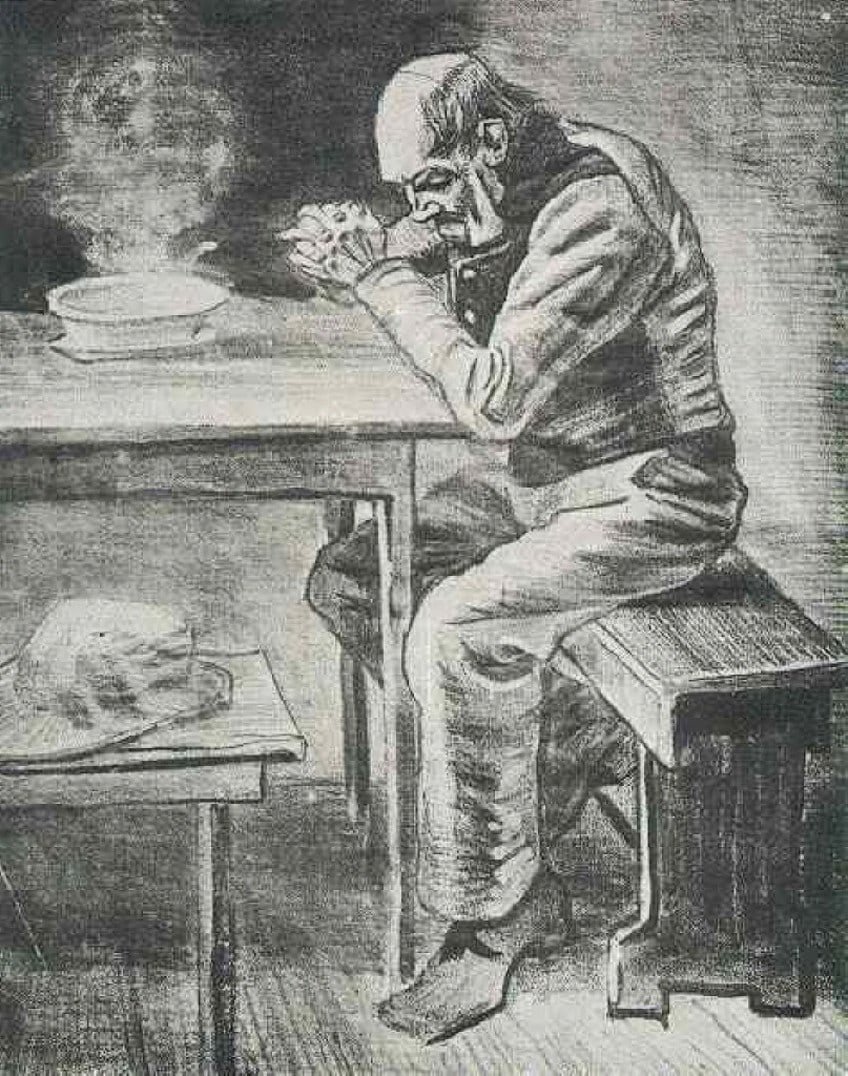
They were later recognized as pioneering masterpieces. Theo offered his brother money in August 1882 to buy supplies for working en plein air. Van Gogh stated that he might now “paint with fresh verve.” He began working on multi-figure compositions in early 1883. He photographed some of them, but when his brother commented that they lacked vibrancy and vitality, he trashed them and switched to oil painting. Van Gogh sought technical help from well-known Hague School artists such as Blommers, as well as painters such as Van der Weele.
When he relocated to Nuenen following his time in Drenthe, he started numerous enormous works but ruined most of them.

Only The Potato Eaters and their accompanying pieces have survived. After a trip to the Rijksmuseum, Van Gogh expressed his love for the Dutch Masters’ fast, efficient brushstrokes, particularly Frans Hals and Rembrandt. He recognized that many of his flaws stemmed from a shortage of expertise and technical knowledge, so he traveled to Antwerp and eventually Paris in November 1885 to acquire and expand his talents.
Theo chastised The Potato Eaters for their gloomy hue, which he felt was inappropriate for a current design. During his sojourn in Paris between 1886 and 1887, Van Gogh attempted to master a new, brighter palette. His Portrait of Père Tanguy (1887) demonstrates his skill with a more vivid palette and demonstrates a maturing manner. Charles Blanc’s color treatise piqued his curiosity and inspired him to explore with complimentary colors.

Van Gogh grew to feel that color’s influence extended beyond the analytical; he stated that “color communicates something in itself.” Color, according to Van Gogh, has an “emotional and ethical significance,” as seen by the gaudy greens and reds of The Night Café (1888), a piece he intended to “convey the tragic impulses of humanity.”
Yellow had the most meaning for him since it represented emotional reality. He utilized the color yellow to represent sunlight, health, and God.
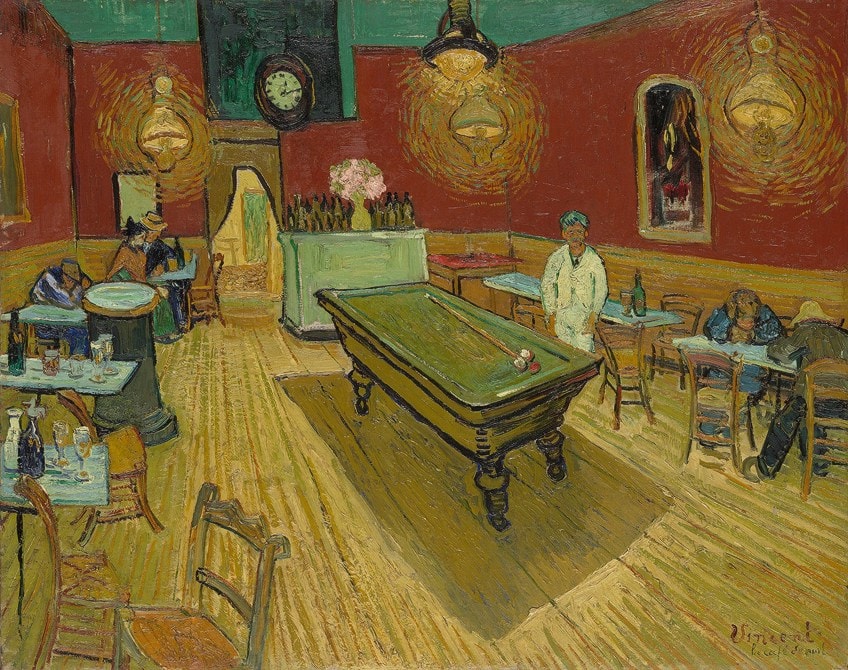
Van Gogh aspired to be an artist of country life and nature and utilized his new palette to create vistas and traditional country life during his first summers in Arles. His conviction in the existence of power behind the natural compelled him to strive to convey a feeling of that force, or the spirit of nature, in his work, often via the use of symbols.
Van Gogh’s sower paintings, which he initially imitated from Jean-François Millet, depict his theological beliefs: the sower as Christ spreading vitality beneath the burning sun.
These were topics and ideas that he frequently revisited to rethink and improve. Vincent van Gogh’s flower paintings are rich in symbolism, but rather than using conventional Christian imagery, he created his own, in which life is experienced under the sunlight and labor is an emblem of life. After creating spring blooms and attempting to capture brilliant sunshine in Arles, he was able to execute The Sower (1888).

Van Gogh preferred to paint in what he termed the “guise of truth,” and he was disdainful of excessively stylized works. He later remarked that Starry Night’s abstraction had proceeded too far and that realism had “faded away too much in the distance.” Hughes characterizes it as a time of profound visual ecstasy: the lights are in a big swirl, evocative of Hokusai’s Great Wave, the motion in heaven above is mirrored by the action of the cypress on the ground below, and the artist’s perception is “transformed into a thick, forceful stream of paint.”
Francis Bacon created a collection of works in 1957 on replicas of The Painter on the Road to Tarascon. Van Gogh’s original was unfortunately lost during WWII. Bacon was motivated by a “ghostly” image and saw Van Gogh as an ostracised outsider, a position that resonated with him. Bacon agreed with Van Gogh’s painting ideas and referenced remarks addressed to Theo:
“True artists do not depict objects as they are, they depict them as they perceive them to be.”

Van Gogh seemed to have been constructing an oeuvre, a collection that expressed his own vision and might be economically successful, between 1885 and his death in 1890. Blanc’s notion of style, that a real painting requires perfect use of color, perspective, and brushstrokes, affected him. Van Gogh used the term “purposeful” to describe works he believed he had perfected, as opposed to studies.
He painted a number of series of studies, the majority of which were still lifes, many of which were done as color experiments or as gifts for friends. The Sower, The Night Cafe, Memory of the Garden in Etten, and Starry Night were among the works he considered to be the most important from that period.

Major Series
Van Gogh’s aesthetic advancements are typically related to the time he spent living in various locations around Europe. He tended to integrate himself in native customs and lighting situations, yet maintaining a highly unique aesthetic perspective throughout. His development as an artist was sluggish, and he was conscious of his limits as a painter.
He traveled about a lot, maybe to introduce himself to fresh visual stimuli and, as a result, to increase his technical expertise.
Melissa McQuillan, an art historian, says the shifts also represent subsequent style developments, and that Van Gogh utilized them to avoid confrontation and as a coping technique when the optimistic artist was confronted with the reality of his current circumstances.
Portraits
The portraits provided Van Gogh with his finest opportunity to earn money. They were “the only thing in art that touches me deeply and gives me a feeling of the limitless,” he claimed. He told his sister that he wanted to create portraits that would last and that he would utilize color to portray their feelings and personalities rather than trying for photographic realism.
Van Gogh’s portraits are generally devoid of those closest to him; he rarely depicted Van Rappard, Theo, or Bernard.
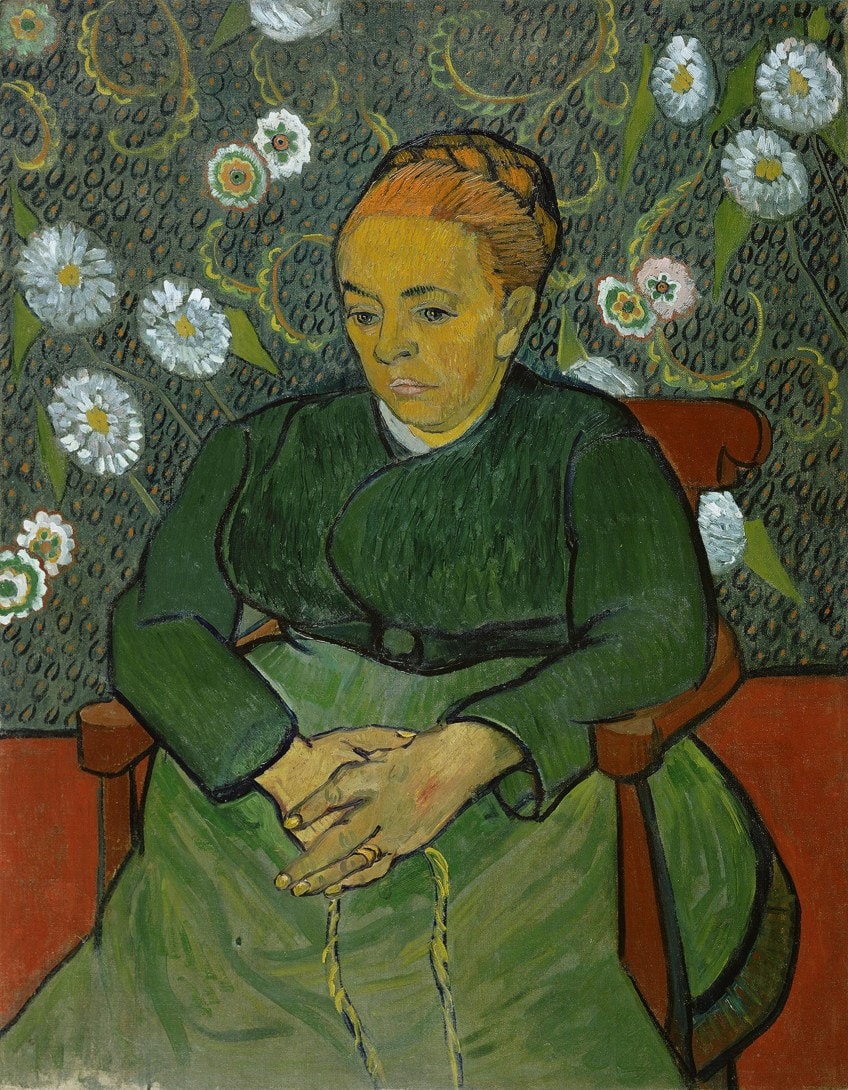
His mother’s portraits were created from pictures. In December 1888, he painted La Berceuse, a figure he considered to be as magnificent as his sunflowers. It features a restricted palette, diverse brushstrokes, and straightforward shapes. It looks to be a collection of portraits of the Roulin family painted in Arles during November and December of that year. The portraits illustrate a stylistic transition from The Postman‘s flowing, controlled brushstrokes and even texture to Madame Roulin with Baby’s frenzied manner, rough surface, wide brushstrokes, and use of a palette knife.

Self-Portraits
Between 1885 and 1889, Van Gogh painted more than 43 self-portraits. They were frequently finished in groups, such as those produced in Paris in mid-1887, and lasted until his death in 1890. Generally, the portraits were studies done at introspective moments when he was hesitant to mingle with people or when he had limited models and had to paint himself.
The self-portraits reveal an extremely high level of self-criticism.
They were frequently created to commemorate significant events in his life; for instance, the mid-1887 Paris series was painted around the time when he became conscious of Paul Cézanne, Claude Monet, and Signac. Heavy paint strains expand forth over the canvas in Self-Portrait with Grey Felt Hat. “With its carefully regulated repetitive brushwork and the peculiar aura derived from the Neo-impressionist arsenal, it was what Van Gogh himself dubbed an “intentional work.” They include a diverse range of physiognomical representations.

Van Gogh’s mental and physical health are typically visible; he may seem disheveled, unkempt, or with a scruffy beard, with profoundly sunken eyes, a weakened jaw, or missing teeth. Some depict him as having large lips, a lengthy face with a broad cranium, or pointed, alert characteristics. His hair is usually red, although it may sometimes be ash-colored.
Van Gogh’s glance is rarely aimed at the observer. The intensity and color of the pictures vary, and the brilliant colors, especially in those produced after December 1888, show the weary pallor of his complexion.
Some represent the artist as having a beard, while others do not. He can be seen with gauze in pictures taken immediately after he injured his ear. Only in a handful of them does he depict himself as a painter. Those that were created in Saint-Rémy depict the head from the right-hand side, which would have been the side directly opposite his wounded ear, as he would have portrayed himself mirrored in his reflection.
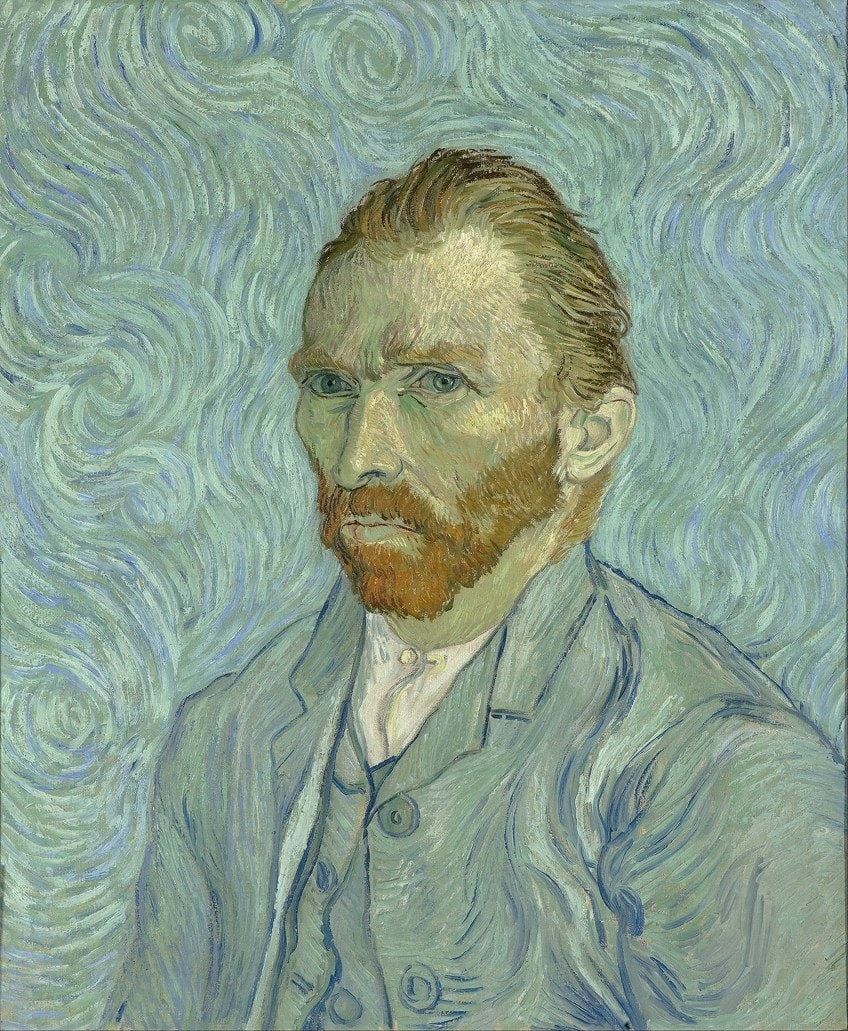
Vincent van Gogh’s Flower Paintings
Van Gogh created various flower-filled landscapes, including lilacs, roses, irises, and, of course, sunflowers. Some of his works illustrate his studies in the language of color. There are two groups of sunflowers that are fading. The first, painted in Paris in 1887, depicts flowers on the ground. The second set, of blooms in a vase in the early dawn light, was finished a year later in Arles.
Both are constructed from densely layered paintings that, according to the London National Gallery, evoke the “look of seed-heads.”
Van Gogh was not worried about infusing his works with subjectivity and feeling in these series; rather, the two series are designed to demonstrate his technical proficiency and methods of work to Gauguin, who was going to visit.

The 1888 artworks were painted during the artist’s uncommon time of optimism. In August 1888, Vincent van Gogh wrote to Theo, “I’m working with the enthusiasm of a Marseillais devouring bouillabaisse, which won’t astonish you when it comes to depicting enormous sunflowers. If I implement this design, there will be about a dozen panels. As a result, the entire thing will be a blue and yellow symphony. I work on it every morning, beginning at sunrise. Because the flowers wilt rapidly, and it’s best to accomplish everything at once.”
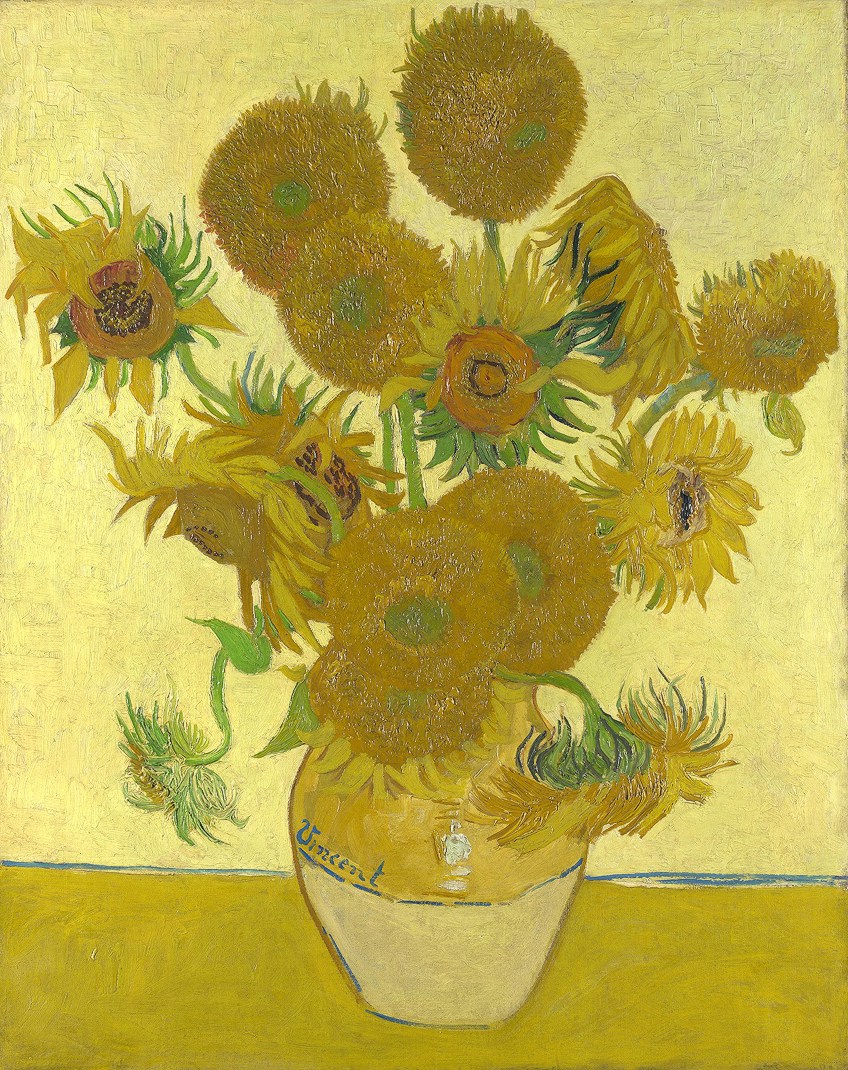
In preparation for Gauguin’s arrival, the sunflowers were created to decorate the walls, and Van Gogh put individual works throughout the Yellow House’s guest room in Arles. Gauguin was blown away and eventually purchased two of the Paris replicas. Nowadays, the series’ major pieces are among his most well-known, acclaimed for the sickening implications of the color yellow and its connection with the Yellow House, the abstract expressionism of the brushwork, and their juxtaposition against frequently gloomy backdrops.
Olives and Cypresses
In Arles, he became enamored with cypress trees, which he depicted in 15 paintings. He breathed new life into the trees, which had previously been portrayed as symbols of death. He began his series of cypresses at Arles with the trees in the background, as windbreaks in meadows; at Saint-Rémy, he moved them to the forefront.
“Cypresses still preoccupy me, I would want to produce something with them like my paintings of sunflowers,” Vincent van Gogh wrote to Theo in May 1889, adding, “They are magnificent in form and proportions like an Egyptian obelisk.”

Van Gogh produced many smaller copies of Wheat Field with Cypresses at the behest of his sister Wil in mid-1889. Swirls and heavily painted impasto characterize the pieces, which include The Starry Night, in which cypresses dominated the forefront. Other significant paintings on cypresses are Road with Cypress and Star (1890), and Cypresses with Two Figures (1890).

During the final six months of 1889, he also completed at least fifteen canvases of olive trees, a subject he found challenging and captivating. Among these paintings are Olive Trees with the Alpilles in the Background (1889), of which Van Gogh said in a letter to his brother, “Finally I have an olive landscape.”
Van Gogh spent a lot of time outside the institution at Saint-Rémy, painting trees in the olive gardens.
Natural life is represented as twisted and arthritic as though a personification of the natural world in these paintings, which are filled with “a continual field of force of which creation is a representation,” according to Hughes.
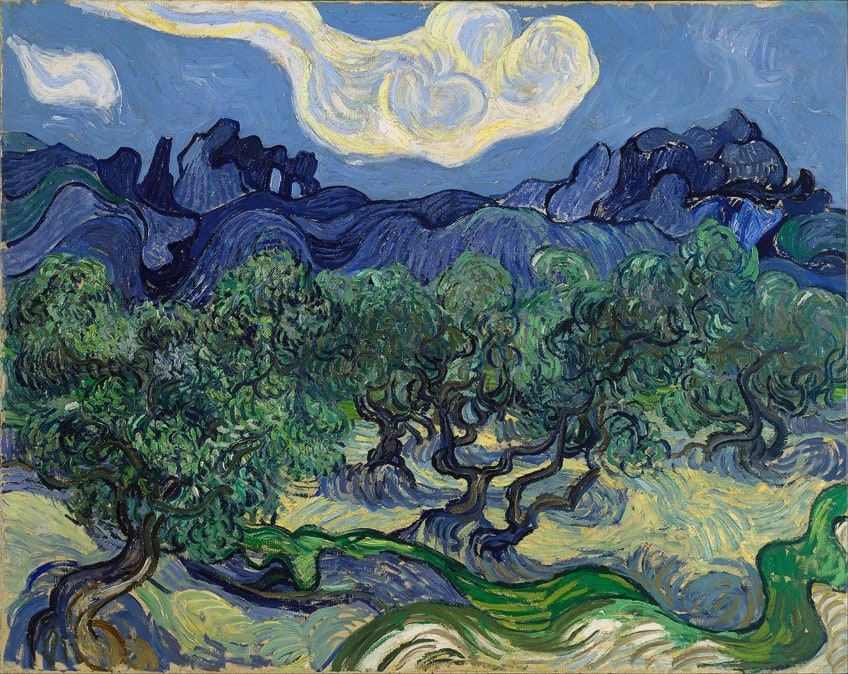
Orchards
The Flowering Orchards was one of the first sets of paintings Van Gogh painted after his stay in Arles in February 1888. The 14 paintings are upbeat, joyful, and graphically descriptive of the approaching spring. They are exquisitely sensitive and devoid of life. He painted quickly, and while he contributed a kind of Impressionism to this series, a strong feeling of his own style began to develop during this era.
The transience of the flowering trees and the passage of the season appeared to correspond with his feeling of impermanence and hope for a new beginning in Arles.

During the spring flowering of the trees, he discovered “a universe of themes that could not have been more Japanese.” During this time, Van Gogh perfected the usage of lighting by subduing shadows and portraying trees as if they were the light source – almost in a religious way. He produced another smaller set of orchards the next year, entitled View of Arles, Flowering Orchards. Van Gogh was captivated by the environment and greenery of southern France, and he frequently visited agricultural gardens near Arles.
His palette was substantially heightened by the brilliant light of the Mediterranean environment.

Wheat Fields
During his travels to the region near Arles, Van Gogh went on various painting expeditions. He painted crops, wheat fields, as well as other countryside monuments in the region, such as The Old Mill (1888), a lovely edifice edging the wheat fields across. Van Gogh depicted the scene from his window in The Hague, Antwerp, and Paris at various times. These paintings resulted in The Wheat Field series, which captured the vista from his hospital rooms at Saint-Rémy.
Many of the later works are gloomy yet ultimately uplifting, and they depict Van Gogh’s quest to regain clear mental health right up to his death. Nonetheless, several of his later pieces indicate his growing misgivings.

Van Gogh stated in a letter from Auvers in July 1890 that he had gotten immersed “in the huge plain against the hills, endless as the sea, exquisite golden.” In May, when the wheat was new and green, Van Gogh was attracted by the fields. His Wheatfields at Auvers with White House depicts a more muted palette of yellows and blues, creating an exquisite harmony.
Van Gogh described “huge fields of wheat beneath disturbed sky” to Theo around the 10th of July, 1890.
Wheatfield with Crows (1890) depicts the artist’s mental condition in his dying days, as described by Hulsker as a “doom-filled picture with ominous clouds and ill-omened crows.” Its dark color and thick brushstrokes evoke a sense of foreboding.

Notable Artworks
As we have seen, Vincent van Gogh created many types of artworks. However, out of his total output, some works of art stand out. Here is a list of Vincent van Gogh’s paintings that are beloved and well-known.
- The Potato Eaters (1885)
- Irises (1889)
- The Starry Night (1889)
- Self-Portrait (1889)
- Almond Blossom (1890)
- Wheatfield with Crows (1890)
- Farms near Auvers (1890)

Recommended Reading
Did you enjoy learning more about Vincent van Gogh’s paintings and life? We have tried to cover a substantial amount of information about the artist, but maybe you would like to learn even more. If so, you can find a list of books that we can recommend that will allow you to dive even deeper into Vincent van Gogh’s artwork and lifetime.
The Letters of Vincent van Gogh (1998) by Vincent van Gogh
Very few painters’ communications are as direct as Van Gogh’s, and the collection shown here, which spans his complete career in the arts, sheds light on every facet of this complex and troubled man’s work and life. Instead of indicating that Van Gogh was capable of profound spiritual and emotional depths, the letters challenge the conventional picture of him as an anti-social maniac and a victim to art.
They frankly and convincingly address his theological struggles, his ill-fated search for love, his tumultuous relationship with his brother Theo, and his battles with mental illness. Above all, they are a passionate personal tale of artistic evolution and a one-of-a-kind portrayal of the creative process. Explanatory biographical paragraphs connect the letters, exposing Van Gogh’s inner voyage as well as the outside realities of his existence. This volume contains the original artwork that accompanied the letters.
- Letters that span the whole of Vincent van Gogh's artistic career
- Shedding light on every facet of the artist's life and works
- An intense personal narrative of artistic development and creation
Van Gogh. The Complete Paintings (2020) by Ingo F. Walther
Vincent van Gogh’s paintings certainly rank up there along with the most admired in the world today. In works like van Gogh’s flower paintings, The Starry Night, and Self-Portrait with Bandaged Ear, we see an artist who is unusually skilled at representing texture and tone, light, and location. Nonetheless, van Gogh faced not only the apathy of his modern audience but also catastrophic spells of mental illness during his lifetime.
His bouts of despair and worry would finally take his life, as he committed suicide soon after his 37th birthday in 1890. This exhaustive study of Vincent van Gogh includes a complete gallery of his paintings as well as articles tracing the life and career of a genius who remains to tower over the world of art to this very day.
Through Vincent’s Eyes: Van Gogh and His Sources (2022) by Eik Kahng
Vincent van Gogh’s unique style arose from a great appreciation for and affinity to the 19th-century art scene. This new look at Van Gogh’s inspirations delves into the artist’s ties with Barbizon School artists Georges Michel, Jean-François Millet as well as Realists like Léon Lhermitte. Van Gogh’s imitation of Adolphe Monticelli, his assimilation of the Hague School via Jozef Israels, and his intense interest in the works of the Impressionists are all explored in new studies. This lavishly illustrated book also covers Van Gogh’s devotion to Eugène Delacroix’s colorism.
We hope you have enjoyed this in-depth look into the life and art of the incredible Vincent van Gogh. Vincent Willem Van Gogh, the prototypical unhappy artist, attempted to communicate his psychological and spiritual state in all of his works, including Starry Night and Van Gogh’s flower paintings. Vincent van Gogh’s paintings, with thickly layered, tactile brushwork done in a brilliant, sumptuous palette, capture the artist’s distinct personality on canvas. Every Vincent van Gogh painting conveys a particular idea of how the master viewed each scene as experienced via his senses, thoughts, and emotions. Van Gogh’s painting style was fundamentally different and emotionally appealing, and it significantly affected painters and movements throughout the 20th century and into the present, assuring his significance for the foreseeable future.
Frequently Asked Questions
When Was Van Gogh Alive?
When was Vincent van Gogh Born? His birthdate was on the 30th of March in 1853. He passed away from suicide on the 29th of July in 1890.
What Was Van Gogh’s Painting Style?
Many people regard Van Gogh’s writings to be an additional sort of artwork since they feature drawings of works, he was working on or had recently completed. These sketches demonstrate van Gogh’s development and the advancement of his masterwork. Van Gogh painted with gloomy and somber hues that fitted his themes at the time, primarily miners and rural farm laborers, throughout his early career. However, when he arrived in Paris in 1886, his style shifted dramatically, inspired by the works of the Impressionists and Neo-Impressionists.
Isabella studied at the University of Cape Town in South Africa and graduated with a Bachelor of Arts majoring in English Literature & Language and Psychology. Throughout her undergraduate years, she took Art History as an additional subject and absolutely loved it. Building on from her art history knowledge that began in high school, art has always been a particular area of fascination for her. From learning about artworks previously unknown to her, or sharpening her existing understanding of specific works, the ability to continue learning within this interesting sphere excites her greatly.
Her focal points of interest in art history encompass profiling specific artists and art movements, as it is these areas where she is able to really dig deep into the rich narrative of the art world. Additionally, she particularly enjoys exploring the different artistic styles of the 20th century, as well as the important impact that female artists have had on the development of art history.
Learn more about Isabella Meyer and the Art in Context Team.
Cite this Article
Isabella, Meyer, “Vincent van Gogh – The Art and Life of Painter Vincent Willem van Gogh.” Art in Context. February 22, 2022. URL: https://artincontext.org/vincent-van-gogh/
Meyer, I. (2022, 22 February). Vincent van Gogh – The Art and Life of Painter Vincent Willem van Gogh. Art in Context. https://artincontext.org/vincent-van-gogh/
Meyer, Isabella. “Vincent van Gogh – The Art and Life of Painter Vincent Willem van Gogh.” Art in Context, February 22, 2022. https://artincontext.org/vincent-van-gogh/.














